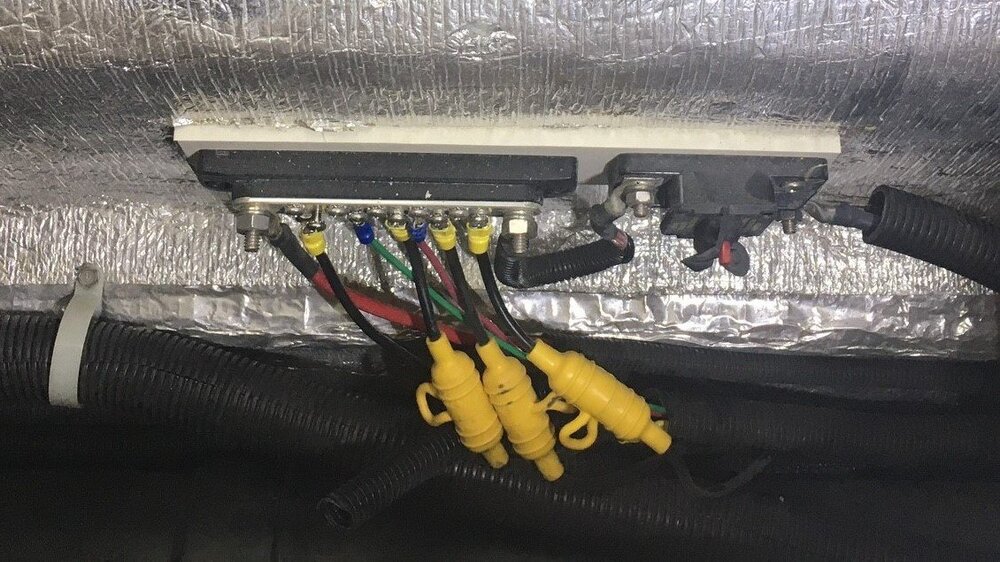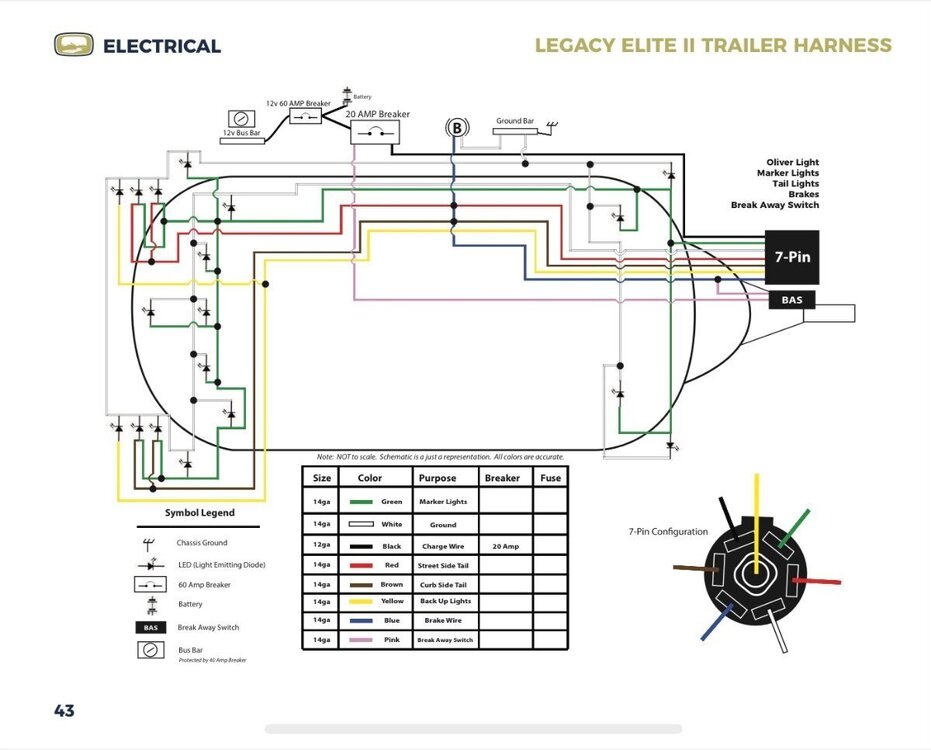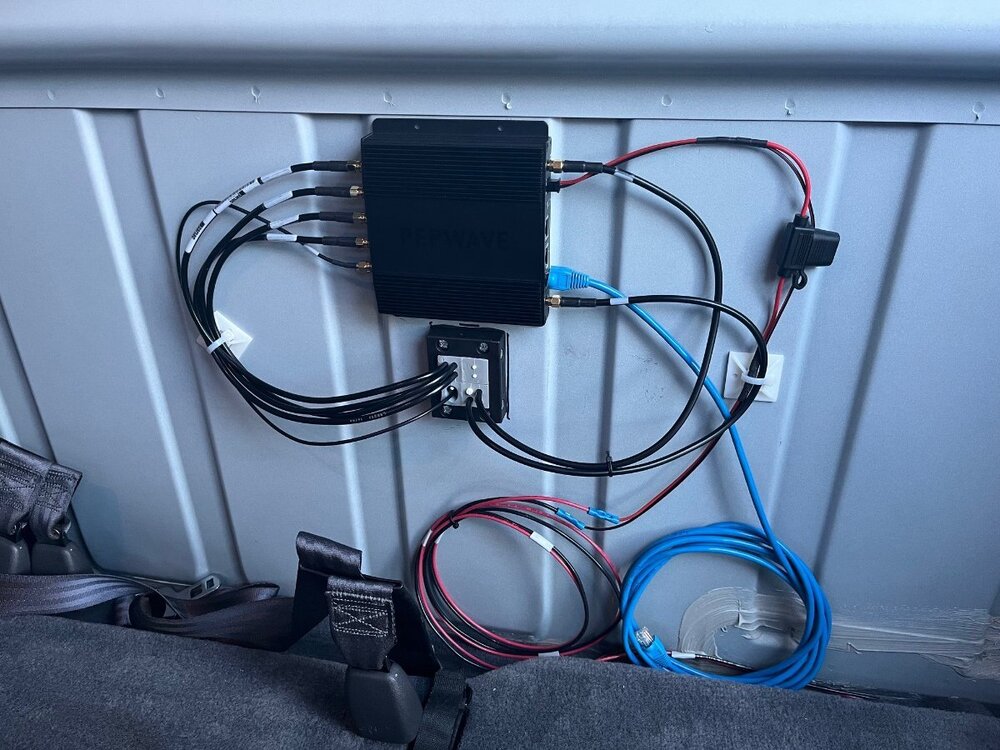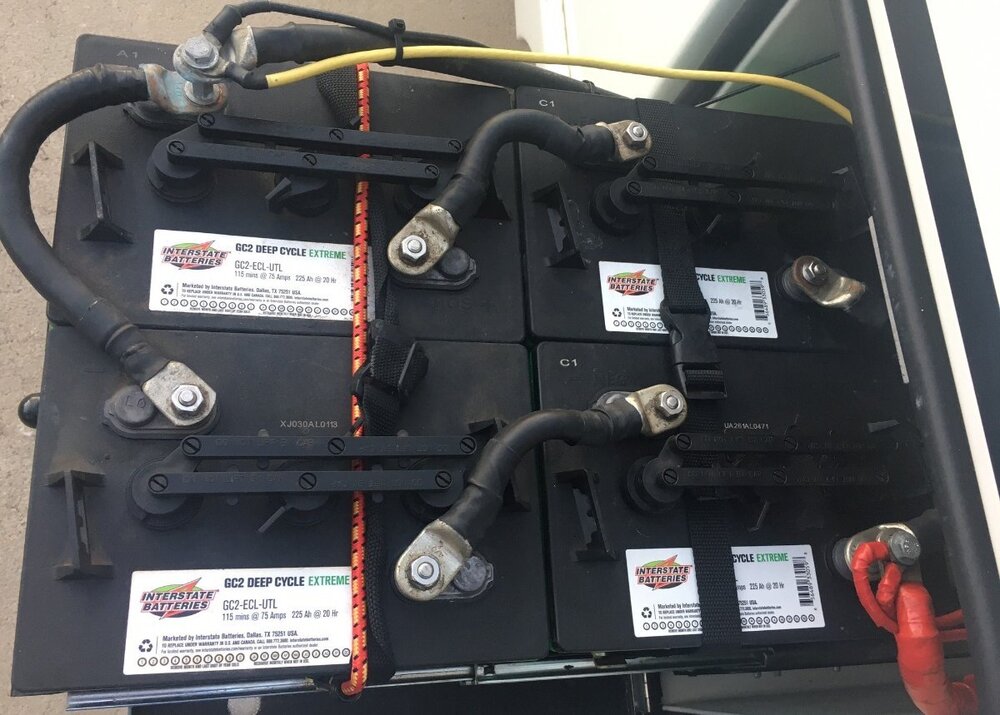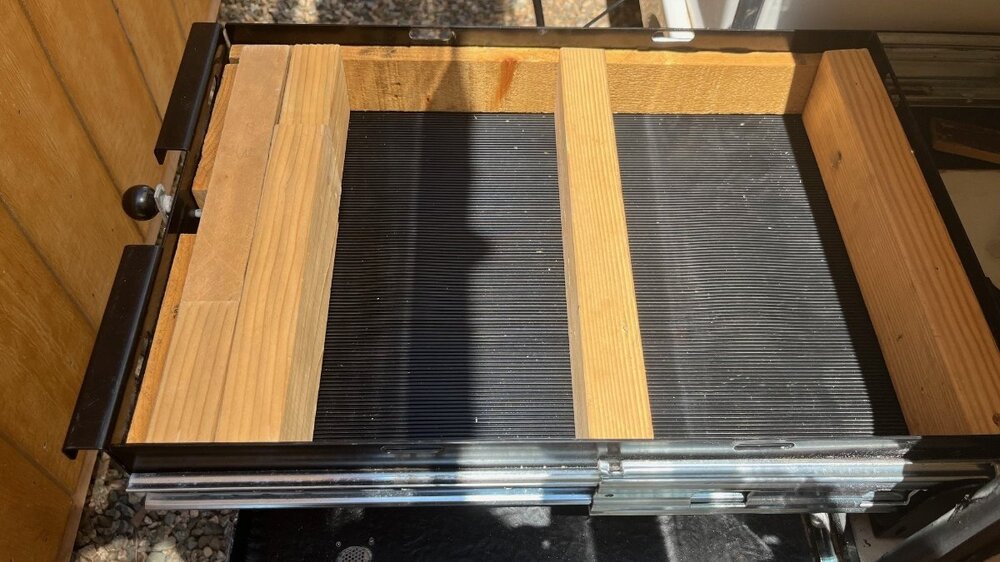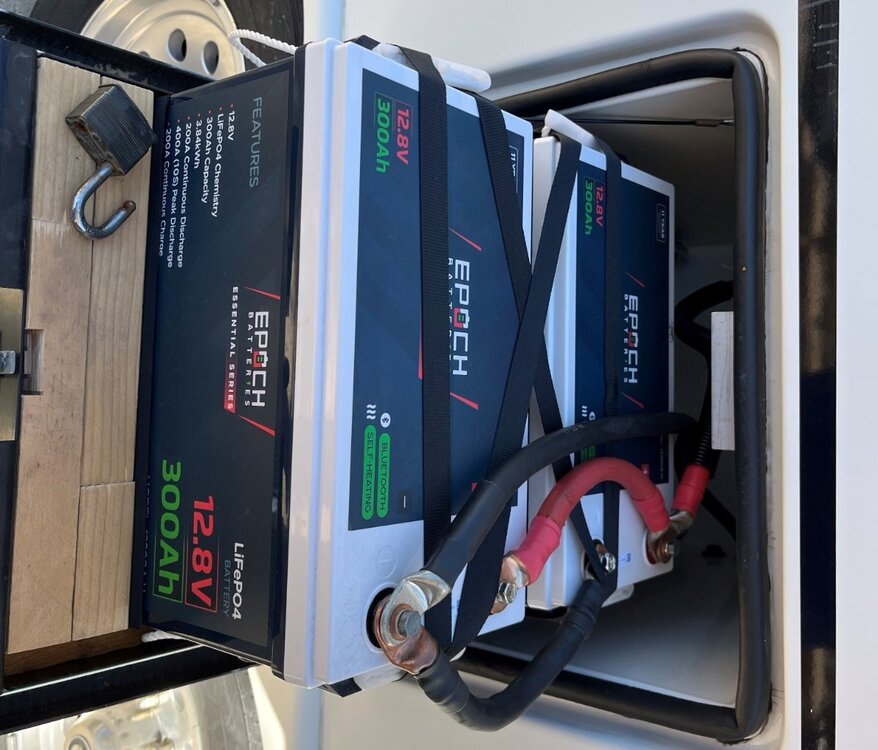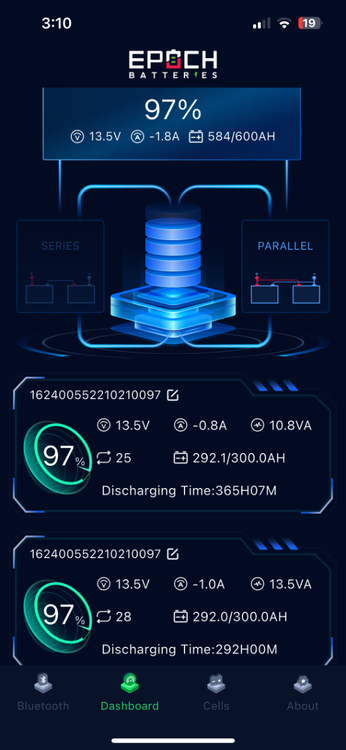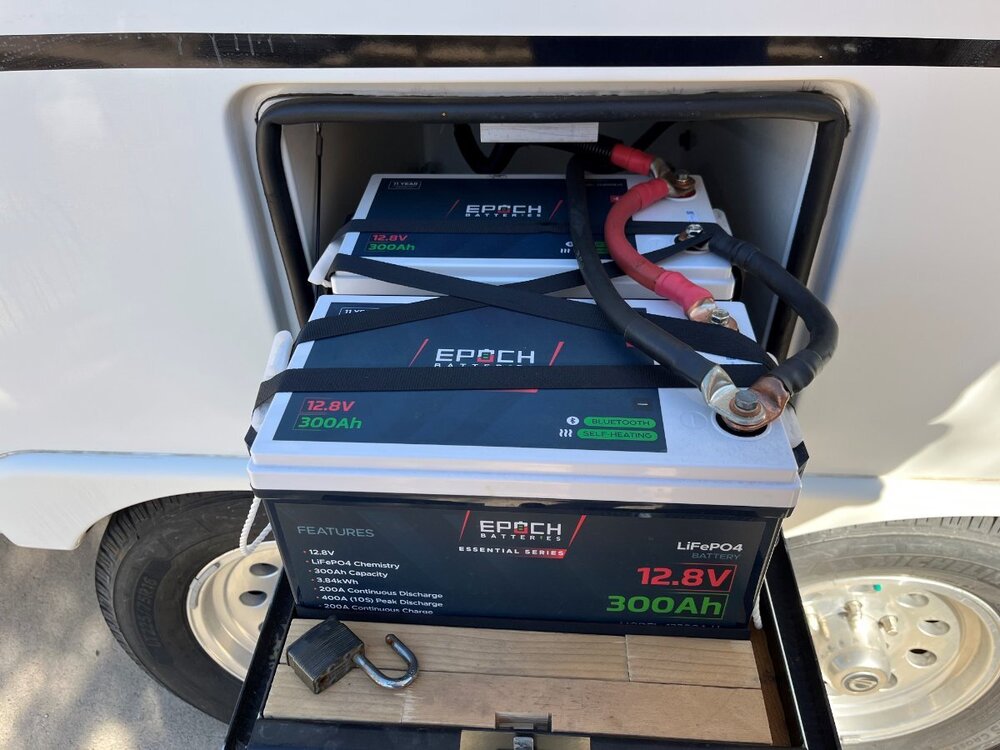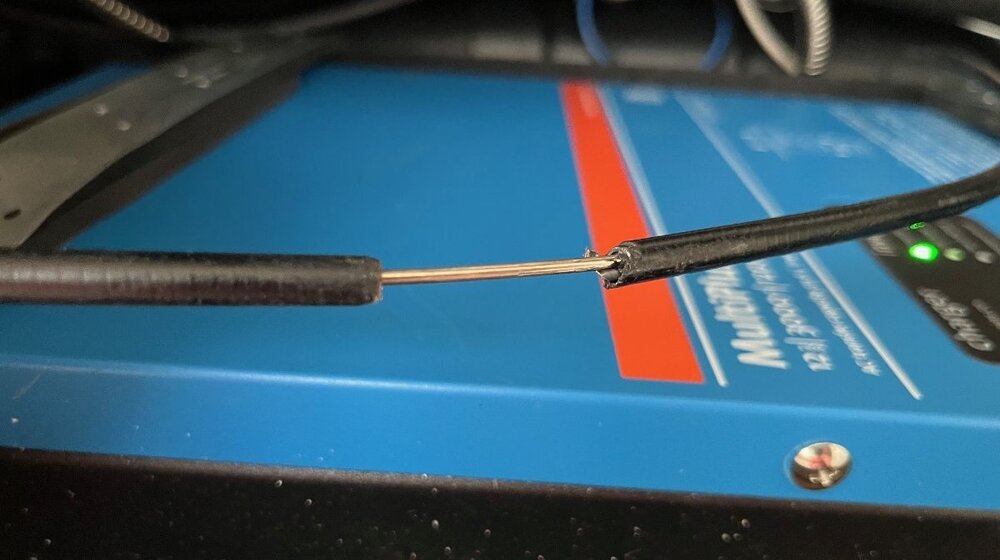-
Posts
2,956 -
Joined
-
Last visited
-
Days Won
206
Everything posted by jd1923
-

Epoc Lithium "Keep-It-Simple" Upgrade Advice
jd1923 replied to tallmandan's topic in Ollie Modifications
It would not damage the alternator whether the engine is running or not. When the engine and alternator are running, the B+ trailer connection is a relatively light 12 AWG wire. In the situation where high AH LiFePO4 batteries are down on SOC (and voltage), after days of camping, this connection can pull amps greater than this gauge wire can handle, which can result in overheating and could burn. And there are likely other scenarios where this connection could be an issue. This is why many of us have installed DC-DC chargers, for charging house batteries while towing, using 4 AWG (or greater gauge) wire. Search this forum for "DC-DC" if interested in these posts. Disconnecting the B+ black wire from the 7-pin connector is easy. Something I did as soon as I found it, even before we upgraded to LiFePO4. Find your 12V+ bus which is often under the streetside bed. In our hull, it was the black wire left side of picture where you see the Phillips is unscrewed (pic 1). Afterwards, I insulated/taped the end and laid it down on the floor below. Also, on our older hull there was no extra 20A breaker as this schematic shows. Ours was hardwired to the bus. But first step, check the 7-pin wiring diagram (pic 2) and find the B+ black and B- white wires on your trailer 7-pin plug. Use a test light or voltmeter to see 12V+ is present between these two wires. After you disconnect your black wire at the bus, check again to find NO voltage present to see if you truly disconnected the correct wire. -
The Pepwave broadcasts Wi-Fi 6 through the Parsec Husky antenna for a very good range. It's nice to connect to one Wi-Fi address on all devices vs. switching to the Mini built-in Wi-Fi. Perhaps the Pepwave can make the Mini connection more efficient vs. the built-in router and it would certainly prioritize data over cell switching to Starlink when needed to save on the 50GB monthly plan. Our T-Mobile 5G business plan is $30/mo after a $20/mo discount for having 2 cell phones on the account. When Starlink HW was $2,500 with $150+/mo service this was NOT an option for us until they offered $50 monthly service. And it's amazing you can pause service when not in use which for our occasional travel is a great cost savings. One thing I cannot find good information regarding is whether the Starlink Mini can run mounted horizontal to the horizon. I have seen a flat mount on some YouTube videos but an angled pole-mount seems to be preferred where the dish can be turned to best direction. Must the dish be angled to the northern sky? Perhaps it comes down to signal strength, less when angled away some from the satellite. All dish models come with some kind of kickstand to create an angle. I need a 12VDC connection when connected to the truck. I guess you are saying that since the dish would be mounted rooftop within a few feet, I would not need to boost the 12VDC voltage. Many want everything possible 12VDC vs. 120VAC, but our Victron inverter is on regardless 24x7. If the truck-mounted dish is at times in the woods, I could always just use the supplied power adapter plugged into the AC power outlet on the side of the Oliver and connect to the Mini's built-in Wi-Fi.
-
Geoff, please give this another thought. I believe you are our resident electronics and switching expert! 😂 Could a relay or something be added to work out this need? I will install the Orion-XS DC-DC 50A non-isolated charger to charge the Oliver house batteries while driving. I have our Pepwave router system installed in our truck, our Oliver tow vehicle (pic 1) and I plan to install the same Orion-TR 12|24 5A converter that you have installed along with a POE switch to wire the Starlink Mini, right next to the Pepwave behind the back seat of our truck. You can see I already planned on the cable entry and ethernet cable is ready. I have a simple toggle switch under the hood to cut power to this system. Presently, I only turn it off when we are parked at home for some time. For over a year with the Pepwave in the truck, we could run it for 3-5 days without worry to the starter batteries getting too low. Adding this converter and a Starlink Mini will take greater power consumption and I worry whether it could even make it an overnight camping! So, could I throw a relay switch to hardwire the 4 AWG wire, bypassing the DC-DC charger so that the house batteries are wired directly to the starter battery? Would charged LiFePO4 batteries at 13.3V or more connected to lead-acid starter batteries at 12.6V hurt anything? Would it bring down the voltage of the house batteries? If not, I could be running the router system with Starlink Mini connected and running to the truck circuit with amperage drawing from the Oliver batteries, where we have a total of 600AH available. It's an odd requirement I know, but we love the Pepwave with Parsec Husky in the truck where it will stay. I use it for back-up internet at home where T-Mobile has 5G service. We use it sometimes while driving and I understand the mini works decently while driving. The Husky is so powerful that 5GHz Wi-Fi 6 surrounds any campsite and much further if you need the 2.4 GHz channel. MobileMustHave claims the Starlink Mini is more efficient running through the Pepwave and the router can be setup to prefer cell where we have unlimited bandwidth when available, over Starlink with the 50GB monthly package. Lately we've camped at a LOT of locations without cell service, so it's time for the mini! I'd want it installed driver's side of the Parsec (pic 2), with an ability to dismount it, add another length of Ethernet cable when we need distance to get to open sky. Thinking of getting this magnet-mount case Trio case: https://www.trioflatmount.com/products/minispeedmount
-
Question for @Snackchaser. On your installation, why did you add a jumper to the two grounds on your isolated Victron 12|24 converter. In doing this, does it not become non-isolated? I know you'll have a good answer and thanks in advance!
-
I checked out this unit, nice combo unit, but cannot find specs on standby power consumption. I really prefer the 12|24 Victron converter that @Snackchaser installed, but I'd go without the timer extra. Like @JT LongI require POE which Geoff did not install. These two items would be a good alternative to the MobileMustHave product, but I do love these guys, spent a lot of money on buying our Pepwave router system from them. Check out these items: https://www.amazon.com/dp/B01D082AX8/ and https://www.amazon.com/dp/B0DKXMVPBG/ This has benefits of being Victron (If it has Bluetooth I'll have 5 Victron products listed on our App!). The Victron charger has a built-in remote switch. It looks like the same, likely China made wiring/terminals. And total price at $120 is about $30 less.
-
Yep, we weren't going to wait in line at Q for a dump station. We dropped some gray when boondocking afterwards (legal in FS and BLM when 500 ft from others and water sources which is easy enough in Arizona). We carried 2 days of gray and a 3/4 full black tank back to the dump station in our neighborhood, carried it up 4500 net in elevation, up the Bradshaw Mountains, but negligible additional weight considering our rig and available GVW. On another trip after 3 nights boondocking at Parowan Gap, there was a free dump at the Sunoco in Cedar City UT. Not a good design for the Oliver as we had to back in uphill and over a driveway hump! You do what you gotta do. The portable ramps help and I've used them many times in similar situations. 🤣
-

Epoc Lithium "Keep-It-Simple" Upgrade Advice
jd1923 replied to tallmandan's topic in Ollie Modifications
Something important to me in determining this layout was an easy disconnect. I did not want a kill switch. Instead I needed the main B- cable, the long run back to the inverter, to be at the outer edge of the battery bay. With this layout, I can just open the battery tray to remove the closest bolt, hence removing the system ground. The B+ terminals are further in so there is little chance of me hitting them with the 1/2" wrench required to disconnect the batteries (see pic above). -

Epoc Lithium "Keep-It-Simple" Upgrade Advice
jd1923 replied to tallmandan's topic in Ollie Modifications
I would NOT suggest using measurements from other installations. Each OEM installation is different and each new installation is different. Measure your specific needs. I noticed in one installation, the same two Epoch 300s that I purchased but in that installation they put the batteries with posts on opposite sides, which required longer cables. I put the terminal sides of the batteries both on the right side. I added a 2x4 in-between the two batteries. The Epoch 300s are 7.6" wide and with the 2x4 made the terminals 9.1" apart. My OEM installation included 2 shorty cables that I gave to the guy that bought my LA batteries AND two cables were just under a foot, long enough to reuse. I cleaned them up and applied new heat shrink and did not have to buy any new 4/0 cable for my battery installation. Before and after pics below. You can barely see the original red cable I reused which is far right off the picture. The black one I reused is shown on the left. I the new installation they actually fit better, less arced. I also added a picture of my tray design. The wood 2x4s made it easy. Notice the rubber toolbox liner underneath. I also used the same rubber to surround each battery so that the batteries would not rub on the wood. -
Good question, John. Tires is another consideration and I will explain this is not the limiting factor in this situation. We have the Michelin Agilis 225/75R16 Load Range E tire on our Oliver which I believe is the OEM standard. And any LT E-rated tire of same size, from any manufacturer, would have the same load specs. Looking at the first row of this table, ONLY 40 PSI is required for the Oliver GTWR of 7,000 LBS (4 x 1,795 = 7,180 LBS). Truly this is all the pressure you need. I run anywhere between 42-46 PSI, thus adding a small safety factor. Any number in that range that I can set all 4 tires to without getting out my air compressor is good enough for me! If any of the four tires are under 42 PSI then I'll air up to 45 PSI on all fours. You can also see that at 65 PSI you can run a load of 10.480 LBS (4 x 2,620). This says it all. So, if you have 5,200 axles with 12" brakes and HD leaf springs, the 12.5K Bulldog, just raise tire pressure to 65 PSI and everything will be in balance to run the 10K LB trailer. This size LT tire can handle over 12K LBS at 80 PSI.
-
The Atmos does this too, but sitting in Ron’s Oliver at the Texas Rally, where temps were mid 80s, not summer humid, his A/C dropped temp from OFF to very comfortable and humidity dropped by 11% at the same time! (In 20-30 minutes) I remember numbers and our friend @Ronbrink has all the temp sensors and gadgets, an extremely well-equipped Oliver! So why does one create humidity and the other does not? Kevin at SDG told me it’s cause the condensate is expelled to the exterior. They both do that. If Australia is hot and dry, same here in Arizona. I want the humidity but NOT fan noise. I figure when it’s cooled off and the fan is running, I’ll be in bed and hit the remote to power off the system! 🤣
-

Epoc Lithium "Keep-It-Simple" Upgrade Advice
jd1923 replied to tallmandan's topic in Ollie Modifications
You’re welcome Dan. Not much of a free monitor, nice promo, the app shows much more info. An Automatic Transfer Switch (ATS) can be added to run the A/C via your 2KW Xantrex, given when not running anything else large. There are posts on that upgrade here. Likely the extra 140AH going to 600AH gives you another hour to 1 1/2 hours. I’m guesstimating the amperage draw of your 11K Dometic. We have the larger 13.5K model. They are as inefficient as they are noisy! The other thing about going to the 300 AH model, is 2 fit in the tray and 3 for 900AH total fits in the battery bay with the slide out tray removed. You cannot get 2x the 460 AH Essentials no matter what. Going to keep your Oliver for a lot of years, the 300s are a better future-proof upgrade. You should have all the 4/0 battery cables you need. Attach a picture if you want me to verify. I needed slightly longer bolts than what Epoch included where the cables were doubled up. Simple HW store item. Finished cables can also be purchased on Amazon and companies like Powerwerx and others. -
Too bad idiot protesters are fire-bombing these Tesla Cybertrucks! I’m not much for the style of this truck, but wow will somebody please give me a Model S! Though I would need a neck brace to do 0-60 in 2 seconds! Might be a good time to buy Tesla stock. Leon said yesterday production will be doubled next year and what about that model that drives itself with no installed controls. That one is also not for me, just give me an S!
-

Epoc Lithium "Keep-It-Simple" Upgrade Advice
jd1923 replied to tallmandan's topic in Ollie Modifications
We use The LevelMatePRO app while backing into a campsite! Can't live without our LevelMatePRO, VictronConnect, Epoch Batteries, Ruuvi Station and Mopeka LP tank sensors and Apps! -
I'm not the warranty worry type and ours is long out of warranty! What is your warranty end-date? Your hull now being about 3 years old. I did not mention the bulldog before, but if you added two 5200 LB axles (which your hull may already have) and say the Alcan leafs that many have added (rated at 2750 LBS ea, 11K total) AND a 12,500 LB rated Bulldog coupler and 2 5/16" ball, you can certainly go over to 10K LBS (unless you really think the Oliver frame would be the weak link). Let's ask Steve to chime in! 🤣 @ScubaRx has all these upgrades including trailer disc brakes and I'll betcha his hull has been running well over 7K, closer to 10K GTW, for longer than a decade!
-
You can rationalize re not ever needing water while on the road, but where are your numbers coming from? There is no such 32+32+15 gallons in our trailers since it is impossible to have FWT, gray and black tanks all simultaneously 100% full! When you use the 32 gal FWT it empties from there to fill the others. We (Mike who replied, I and so many others ) would suggest you should carry some water or someday you'll be sorry. You could fill the FWT adding 32G weighing 266 LBS total. Or you could half fill it, for emergency use only, adding just 133 LBS to your GTW. Pick your poison! 🤣
-

Epoc Lithium "Keep-It-Simple" Upgrade Advice
jd1923 replied to tallmandan's topic in Ollie Modifications
As I mentioned, I prefer not to add displays where unnecessary. This is the readout on my Epoch app today. The app is free to download. I’m presently using 1.8A as she sits. It’s snowing this afternoon, and I rarely plug into shore power, so no sun no charging. Our Victron inverter/charger takes 1A on standby which I leave on 24x7. We also keep outside Courtesy Lights on (0.3A) and parasitic draw another 0.5A. This app is all you really need and perhaps Xantrex and/or Zamp apps. Love the apps! You cannot read a mounted display while towing or sitting at home. -

Epoc Lithium "Keep-It-Simple" Upgrade Advice
jd1923 replied to tallmandan's topic in Ollie Modifications
Good thought to buy now. This sale will likely repeat, but most often it is 10% OFF. I have worked a complete upgrade of our Oliver to Victron but will keep this simple. Two 300AH Epoch Essentials fit nicely fit (see pic). Only one 460AH will fit so upgrade possibilities are limited. Unless you're ever considering an inverter upgrade to run A/C for a few hours on inverter, you are correct in thinking 460AH is all you need and double the usable AH in what you have presently in lead acid batteries. All you need to do is: 1) Install the new batteries in the battery bay. A cut-off switch is preferred by some who park their Oliver in covered storage. I prefer to not add extra connections. I go without and merely remove the negative battery cable when necessary. 2) You need to reconfigure (software setup) both your Xantrex and Zamp SC for LiFePO4 batteries. This is usually simple yet tedious. There are others here who have done so. I have not owned either product but worked the same for our Victron and Blue Sky chargers. 3) I was not aware that the "460aH V2 battery comes with a nice wired remote state-of-charge display monitor." My Epoch Essentials 300AH batteries did not. I can see battery State-of-Charge (SOC) % and +/- Amp usage in both my Victron and Epoch Bluetooth Apps. I use no displays, so nothing is installed into the walls of our inner hull. Hope this helps! Best wishes, JD -
The Oliver is made to carry this weight, up to 7,000 LBS and several members here have upgraded axles/brakes and leaf springs to carry 10,400 LBS. Hate to play engineer on you, but 600 LBS is 72 gallons of water. I carry that much weight in water but you can't (32G FWT, 6G, 3G plumbing and 35G in our extra FWT in the truck bed). That's 76 gallons which comes to 633 LBS and I have calculate I can carry this weight and have 1300 LBS available GVW between our Oliver at 6500 LBS and another 800 LBS we could put in our truck bed. Say you filled your FWT and primed the plumbing, you'd have 35 gallons on board. Use some of it and if some is in the gray or black tanks (unless compost) matters not. I see you have on-demand hot water. This is under 300 LBS. Half fill the tank for 150 LBS. If you run into bad weather you can stop-over for a night or two. If you break down, you can live in your trailer while waiting for a roadside repair. You may learn to 'roll' differently at some point. Full of water and batteries charge, we can live in relative luxury for 5 days until the gray needs dumping and over 10 for the black and our batteries will never be low unless I was to run A/C for a few hours. About a dozen Oliver owners dry-camped the Q this winter. @rich.dev was out there for months w/o hook-ups! Living out West you're not enjoying camping if only staying at campsites! 🤣
-
Yes, good idea. You could mount the RO system to a metal stand that is small enough to slide into the rear basement/trunk area with quick disconnects to the water line. You are certainly hung up on that City Water line, so keep in mind you would not have RO water when taking a lunch break on the road and of course not when dry camping or whenever not connected to a hose. Personally, I could not fathom living fulltime in an Oliver ALWAYS requiring hookups. Last trip out, I left our water tanks empty thinking there was good water at our first campsite. Wanted to use the toilet and wash up during a rest stop and we couldn't. First and last time we ever leave home without our fresh tank full, HWH full and all plumbing lines primed! Many of us think of the four (4) water lines that need to be free of water when below freezing (City Water, Fresh Water, Boondocking inlet and Black tank rinse). One reason I use compressed air vs. the nasty pink stuff. This is my procedure. I added step 13 from input from another owner, but I've never used plumbing antifreeze anywhere in any RV. Plumbing P-traps can freeze without harm since they are not a contained system and can simply expand upwards when freezing, like making ice cubes in a tray.
-
SDG includes an new thermostat that they would install. Ron in the thread above has shown how the original Dometic thermostat can be rewired for furnace only. The Atmos is controlled by the surface panel or remote.
-
Worked this step yesterday. The new cable pulled into place as written above. See picture, taken under the streetside bed. On the left is the new cable. On the right is the cut-off sheath of the old cable. Then I pushed these two sides together, taped them together with electrical tape, and it pulled through nicely. Don't forget to put the nut on the new cable before pulling this! Now the entire waste valve system is restored. The rebuilt gray is a feather-lite pull and push. The black still takes a little tug, due to the 144" cable and the 180 degree turn at the end, but it is much better than before. We should be good for many more years to come.
-

HOW TO: VIP 3000 Electric Stabilizer Jack Service
jd1923 replied to John E Davies's topic in Mechanical & Technical Tips
I replaced the double USB-A with these since we have both kinds of cords: https://www.amazon.com/gp/product/B0B1DHNLDS/ref=ppx_yo_dt_b_search_asin_title?ie=UTF8&th=1


